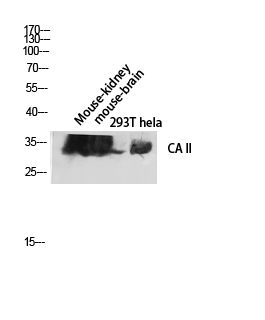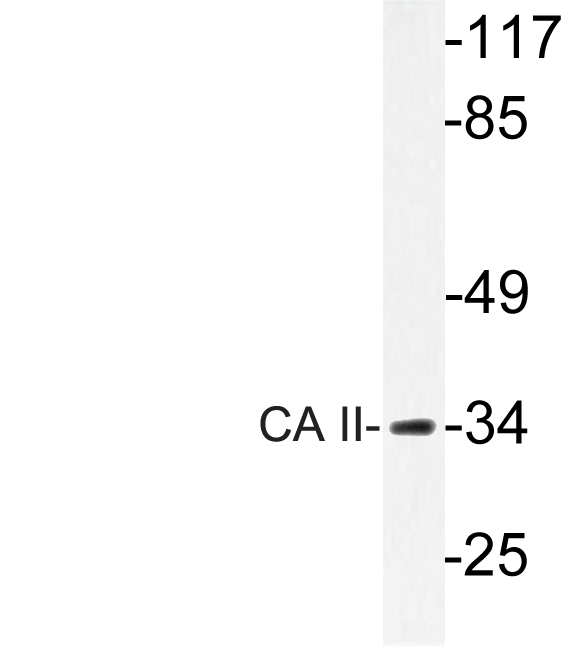CA II Polyclonal Antibody
- Catalog No.:YT0573
- Applications:WB;IHC;IF;ELISA
- Reactivity:Human;Rat
- Target:
- CA II
- Fields:
- >>Nitrogen metabolism;>>Metabolic pathways;>>Proximal tubule bicarbonate reclamation;>>Collecting duct acid secretion;>>Gastric acid secretion;>>Pancreatic secretion;>>Bile secretion
- Gene Name:
- CA2
- Protein Name:
- Carbonic anhydrase 2
- Human Gene Id:
- 760
- Human Swiss Prot No:
- P00918
- Mouse Swiss Prot No:
- P00920
- Rat Gene Id:
- 54231
- Rat Swiss Prot No:
- P27139
- Immunogen:
- The antiserum was produced against synthesized peptide derived from human CA II. AA range:180-229
- Specificity:
- CA II Polyclonal Antibody detects endogenous levels of CA II protein.
- Formulation:
- Liquid in PBS containing 50% glycerol, 0.5% BSA and 0.02% sodium azide.
- Source:
- Polyclonal, Rabbit,IgG
- Dilution:
- WB 1:500 - 1:2000. IHC 1:100 - 1:300. ELISA: 1:40000.. IF 1:50-200
- Purification:
- The antibody was affinity-purified from rabbit antiserum by affinity-chromatography using epitope-specific immunogen.
- Concentration:
- 1 mg/ml
- Storage Stability:
- -15°C to -25°C/1 year(Do not lower than -25°C)
- Other Name:
- CA2;Carbonic anhydrase 2;Carbonate dehydratase II;Carbonic anhydrase C;CAC;Carbonic anhydrase II;CA-II
- Observed Band(KD):
- 29kD
- Background:
- The protein encoded by this gene is one of several isozymes of carbonic anhydrase, which catalyzes reversible hydration of carbon dioxide. Defects in this enzyme are associated with osteopetrosis and renal tubular acidosis. Two transcript variants encoding different isoforms have been found for this gene. [provided by RefSeq, Jun 2014],
- Function:
- catalytic activity:H(2)CO(3) = CO(2) + H(2)O.,cofactor:Zinc.,disease:Defects in CA2 are the cause of autosomal recessive osteopetrosis type 3 (OPTB3) [MIM:259730]; also known as osteopetrosis with renal tubular acidosis, carbonic anhydrase II deficiency syndrome, Guibaud-Vainsel syndrome or marble brain disease. Osteopetrosis is a rare genetic disease characterized by abnormally dense bone, due to defective resorption of immature bone. The disorder occurs in two forms: a severe autosomal recessive form occurring in utero, infancy, or childhood, and a benign autosomal dominant form occurring in adolescence or adulthood. Autosomal recessive osteopetrosis is usually associated with normal or elevated amount of non-functional osteoclasts. OPTB3 is associated with renal tubular acidosis, cerebral calcification (marble brain disease) and in some cases with mental retardation.,function:Essentia
- Subcellular Location:
- Cytoplasm . Cell membrane . Colocalized with SLC26A6 at the surface of the cell membrane in order to form a bicarbonate transport metabolon. Displaced from the cytosolic surface of the cell membrane by PKC in phorbol myristate acetate (PMA)-induced cells. .
- Expression:
- Ovary,
- June 19-2018
- WESTERN IMMUNOBLOTTING PROTOCOL
- June 19-2018
- IMMUNOHISTOCHEMISTRY-PARAFFIN PROTOCOL
- June 19-2018
- IMMUNOFLUORESCENCE PROTOCOL
- September 08-2020
- FLOW-CYTOMEYRT-PROTOCOL
- May 20-2022
- Cell-Based ELISA│解您多样本WB检测之困扰
- July 13-2018
- CELL-BASED-ELISA-PROTOCOL-FOR-ACETYL-PROTEIN
- July 13-2018
- CELL-BASED-ELISA-PROTOCOL-FOR-PHOSPHO-PROTEIN
- July 13-2018
- Antibody-FAQs
- Products Images

- Western blot analysis of Mouse-kidney mouse-brain 293T hela lysis using CA II antibody. Antibody was diluted at 1:2000

- Immunohistochemistry analysis of CA II antibody in paraffin-embedded human lung carcinoma tissue.

- Western blot analysis of lysate from rat heart cells, using CA II antibody.



